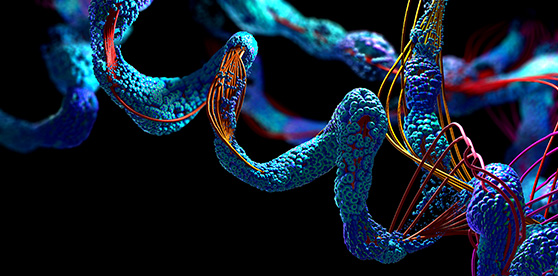Studies suggest that H2-relaxin was synthesized to produce the compound known as B7-33. Research suggests that B7-33 may have an action similar to that of h2-relaxin, but it does not boost the generation of cAMP. It has been hypothesized that its actions are made obvious by the decreased fibrosis in chronic and acute disorders, such as lung inflammation, heart failure, renal, and other conditions. In research models of heart injury, B7-33 has been suggested to decrease the production of scar tissue. In the battle against certain vascular illnesses, such as preeclampsia, which may occur during pregnancy, some researchers speculate that it might be an important additional weapon in the armory.
B7-33 Peptide: What is it?
The naturally occurring protein H2-relaxin has been artificially replicated as a soluble, single-chain peptide called B7-33. Findings imply that B7-33 may have characteristics comparable to h2-relaxin; however, it does not appear to stimulate the generation of cAMP. The B7-33 peptide has been purported to enhance matrix metalloproteinase 2 (MMP2) production and extracellular collagen breakdown. Additionally, it may trigger ERK1/2 activation.
B7-33 Peptide Properties
The cAMP pathway is not activated, although it has a considerable affinity for the RXFP-1 receptor. Instead, the peptide may activate a pathway known as the pERK pathway, which may suppress the cell cycle in the G1 phase and is known to be impacted in illnesses such as Alzheimer’s disease and Crutzfeld-Jacob disease.
Numerous outcomes will be brought about due to the compound’s alleged suppression of the cell cycle advancement in RXFP-1 receptor cells. Researchers speculate that the anti-fibrotic potential of B7-33 may boost the pERK1/2 signaling, increasing the production of the matrix metalloproteinase (MMP)-2 enzyme. MMP-2 is responsible for degrading collagen. It is indicated that B7-33 does not stimulate cAMP since stimulation of cAMP is thought to control some of the actions that promote tumor growth.
B7-33 Peptide and Fibrosis
Scarring or the disorganized regeneration of tissues are both examples of fibrosis. It is the last stage of several chronic illnesses, including those of the cardiovascular system and the lungs, as well as cirrhosis of the liver and abnormal wound healing. It is generally agreed that fibrosis is the fundamental factor in organ failure. Laboratory studies have suggested that H2-relaxin in the aftermath of fibrosis results in vasodilatory effects and a decrease in the long-term scarring impact of heart injury. Despite this, H2-relaxin has a few drawbacks, including its being difficult to manufacture. The risk of developing cancer and an increased heart rate are both consequences of this factor. Most of these negative effects are attributable to the stimulation of the cAMP pathway, which made it possible to research B7-33.
As suggested by studies conducted by Dr. Akhter Hossain, one of the primary creators of B7-33, it may stimulate the creation of MMP-2 to a somewhat greater extent than H2-relaxin. The findings purported a significant improvement in cardiac function and a fibrosis regression in rat models of MI-induced heart failure. The result seemed to be an apparent improvement in heart function and a reduction in long-term symptoms such as problems from heart failure. Research suggests that B7-33 may prevent around half as much scarring in the heart as would otherwise occur after an injury. The same outcomes have been speculated in mice asthma and lung fibrosis models.
Researchers gave B7-33 to mice models of prostate cancer, and they speculated that the compound did not stimulate the development of tumors even at the concentrations necessary to cure fibrosis. The fact that B7-33 may work via the pERK pathway rather than the cAMP route makes this possibility more acute.
Alien bodies in the bloodstream or otherwise identified in the organism are typically fought off or eliminated by the organism’s native cells. When elimination is impossible, the organism may fight foreign bodies via fibrosis. This may reduce the capacity of the foreign bodies to cause damage, including sickness, mutations, and dysfunctions. In the case of an implant, this becomes a problem. In this particular instance, fibrosis is responsible for malfunction or implant deterioration, as well as artery obstruction decreased blood flow, and a heart attack.
B7-33 has been hypothesized to provide a potentially protective layer for implants. As suggested by animal research studies conducted by scientists, the coating made from B7-33 appeared to lower the thickness of fibrotic capsules by around 50% in six weeks. Studies imply that B7-33 might eliminate the need for research models to ingest systemic compounds to reduce the fibrosis that develops around implanted medical devices, making it possible to implant devices in a much wider variety of research models, including those of more severe illnesses.
B7-33 and Blood Vessels
The results of clinical studies conducted on male Wistar rats suggest that the substance may promote bradykinin-mediated endothelium-dependent relaxation in arteries. This is the mechanism by which serelaxin exerts its vasoprotective properties. The endothelium-derived hyperpolarization in the vascular beds is increased due to this factor. Because of its potential to promote vasorelaxation, B7-33 may prove to be an indispensable adjunct in the context of some cardiovascular disorders, such as preeclampsia, which may occur during pregnancy.
References
[i] Praveen, P., Kocan, M., Valkovic, A., Bathgate, R., & Hossain, M. A. (2019). Single chain peptide agonists of relaxin receptors. Molecular and cellular endocrinology, 487, 34-39.
[ii] Yegorov, S., Bogerd, J., & Good, S. V. (2014). The relaxin family peptide receptors and their ligands: new developments and paradigms in the evolution from jawless fish to mammals. General and comparative endocrinology, 209, 93–105. https://doi.org/10.1016/j.ygcen.2014.07.014
[iii] Hossain, M. A., Kocan, M., Yao, S. T., Royce, S. G., Nair, V. B., Siwek, C., Patil, N. A., Harrison, I. P., Rosengren, K. J., Selemidis, S., Summers, R. J., Wade, J. D., Bathgate, R. A. D., & Samuel, C. S. (2016). A single-chain derivative of the relaxin hormone is a functionally selective agonist of the G protein-coupled receptor, RXFP1. Chemical science, 7(6), 3805–3819. https://doi.org/10.1039/c5sc04754d
[iv] Teerlink, J. R., Cotter, G., Davison, B. A., Felker, G. M., Filippatos, G., Greenberg, B. H., Ponikowski, P., Unemori, E., Voors, A. A., Adams, K. F., Jr, Dorobantu, M. I., Grinfeld, L. R., Jondeau, G., Marmor, A., Masip, J., Pang, P. S., Werdan, K., Teichman, S. L., Trapani, A., Bush, C. A., … RELAXin in Acute Heart Failure (RELAX-AHF) Investigators (2013). Serelaxin, recombinant human relaxin-2, for treatment of acute heart failure (RELAX-AHF): a randomised, placebo-controlled trial. Lancet (London, England), 381(9860), 29–39. https://doi.org/10.1016/S0140-6736(12)61855-8
[v] Marshall, S. A., O’Sullivan, K., Ng, H. H., Bathgate, R. A. D., Parry, L. J., Hossain, M. A., & Leo, C. H. (2017). B7-33 replicates the vasoprotective functions of human relaxin-2 (serelaxin). European journal of pharmacology, 807, 190–197. https://doi.org/10.1016/j.ejphar.2017.05.005








